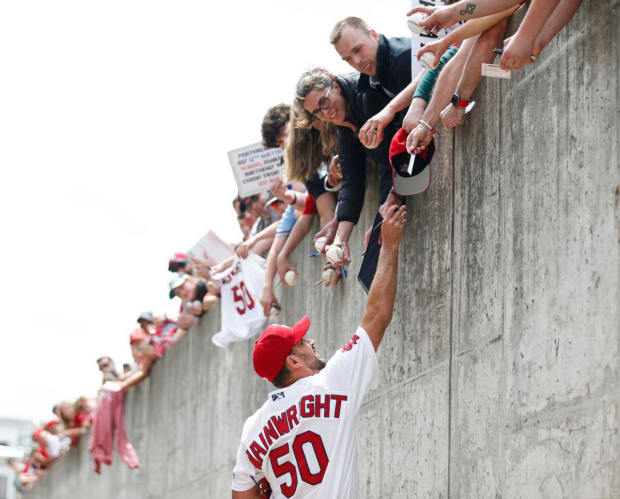Two powerful karmic forces met on the field Wednesday night in St. Louis. The first: whatever has condemned the Angels to falter continuously, seemingly against all odds and despite the best efforts of Mike Trout and Shohei Ohtani. The second: whatever is currently plaguing the Cardinals.
Ohtani struck out 13 in five innings and went 3-for-5 with a double. He made history—joining Babe Ruth as the only players in modern history to record 500 strikeouts as a pitcher and 100 home runs as a hitter. With the Angels being the Angels, however, none of this guaranteed a win. They entered the ninth inning trailing by a run, a familiar script ready to play out for the ending.
At which point the unstoppable force of the Angels’ organizational misery ran up against the immovable object of the Cardinals’ current nightmare. And the latter emerged as more powerful. St. Louis pitcher Giovanny Gallegos gave up ninth-inning home runs to Jake Lamb and Mike Trout, and the Cardinals lost, 6–4.
That continues the Cardinals’ worst start to a season in decades. They sit in last place in the NL Central—a position they have finished in only twice in the last century—and have offered little in the way of hope for fans. Of all MLB’s grand surprises this season? With all due respect to the surging Pirates, there might not be one more shocking than the faltering Cardinals. This is a team that has made four consecutive playoff appearances and previously seemed poised for a fifth. Now? Yes, it’s still only just barely May, but any path to the postseason is looking like an uphill climb. (The Cardinals’ playoff odds on FanGraphs dropped from 67% on Opening Day to 24% on Thursday.) The club’s performance issues have been layered. But here are three of the biggest ones.
1. This pitching staff is all over the place
Their 92 staff ERA+ is among the worst in the NL. Their starters have struggled to get results or go deep into games—they have a 5.00 rotation ERA with fewer quality starts than anyone in the NL except the Mets—and the bullpen has been erratic in providing relief. Theoretically, this staff has been designed to generate plenty of soft contact. (Their 45.8% groundball rate is the fourth highest in baseball.) Yet no team has actually induced less soft contact: St. Louis’s 12.6% soft-hit rate is the lowest in baseball, which means, of course, that no pitching staff is getting more medium- and hard-hit balls. There have been all sorts of specific problems with individual pitchers. But as a group, they’ve been consistently failing to perform in the specific way they’re built to.
Another factor? The Cardinals have been very committed to the group they started the season with. You’ll often see a team with a struggling pitching staff try bumping up reinforcements from Triple A or sending a pitcher to the IL at the first sign of discomfort. (The hapless A’s, for instance, are tied for second in most pitchers used this year, with 22.) But the Cardinals haven’t done that. In fact, only four teams have used fewer pitchers this year. The average MLB club has seen 18 pitchers make at least one appearance through Thursday; St. Louis had turned to just 16. That’s not necessarily a problem in and of itself—giving a staff a vote of confidence by keeping them intact and letting them work through their issues on their own in the majors can be fine. But given how it’s worked out so far? It’s worth asking what it might take for a change. Adam Wainwright is on his way back from injury and should be making his season debut this weekend. But it would make sense to consider shaking it up even more.

Nathan Papes/Springfield News-Leader / USA TODAY NETWORK
2. They’re not executing the little things
No team has recorded more outs on the base paths than the Cardinals. (They’ve made 12 in their first 31 games.) That’s not a metric that includes caught stealing; it accounts for only outs made in the process of routine baserunning. Which is precisely the issue: For a group with an organizational reputation of executing the little things well, St. Louis has been shockingly derelict in that department this year. They’re getting caught making basic errors and being trapped in mental lapses. They rank 29th in defensive efficiency. (Only the Reds have been worse.) Lots of small mistakes are piling up here, in the field and on the base paths alike. No individual error like that is damning. But enough of them can be—and this has been more than enough.
3. Whither Nolan Arenado?
The offense, on balance, has not been a major issue here (at least not compared to the other problems). Their 103 team OPS+ is respectable enough—if not the kind of performance this fan base has been taught to expect. But they’ve done that without much from one of their biggest names, as Arenado has been disastrous at the plate. His strikeout rate has almost doubled from what it was last year, which seems like a holistic problem, with his chase rate spiking on fastballs, breaking balls and offspeed pitches alike. His underlying stats don’t suggest a change is around the corner. (In fact, his xWOBA—expected weighted on base average, using launch angle and expected velocity to determine what a hitter’s performance “should” be, stripping out randomness and luck—is among the bottom 10% of hitters in MLB.) There have been no bright spots here.
Do the Cardinals need a typical MVP-caliber performance from Arenado to succeed as a team? No. (Especially with another Nolan—23-year-old DH Nolan Gorman—stepping up and performing in his name mate’s stead.) But with as many other issues as this club is having, every little bit helps, and Arenado’s struggles have been hard to ignore.







